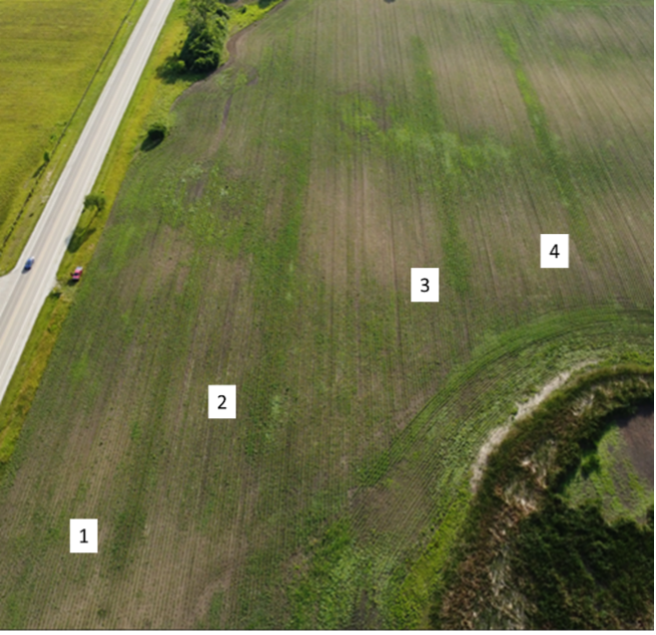Composting is one of the most environmentally practical ways to enhance your soil by taking advantage of the food web. In a fact sheet produced by the US Composting Council (USCC), they noted that by increasing soil organic matter (SOM), improving water retention, and boosting plant nutrient uptake, compost can reduce nutrient losses. This document also states that every 1% increase in SOM can increase water holding capacity by 27,000 gallons per acre. Soil Scientist Vytas Pabedinskas conducted a trial in Lake County, IL that revealed faster germination, growth, and greening up in corn after the addition of organic matter. Captured in early June, one month after planting, the below drone photo of the trial field illustrates 4 darker green vertical stripes where compost was applied.
The Compost Council of Canada’s study Improving Organic Waste Diversion through a Field Test of Greenbin-Derived Compost included trials at individual farms across Ontario. According to their study, “ Through its addition of natural nutrients and organic matter to farm soils, soils are realizing increased microbial activity, enhanced moisture control and soil structure, helping produce healthier plants more resistant to drought, pests and disease.” Although the benefits of utilizing compost as a soil amendment have been scientifically proven, they noted significant barriers to widespread adoption of this practice amongst farmers, including financial constraints, time commitment, hesitancy of short-term lessees to invest in long-term soil health benef its, and lack of government support for the compost industry.

SOURCING & APPLICATION CONSIDERATIONS
The National Center for Appropriate Technology’s ATTRA Sustainable Agriculture program provides information on suggested amounts of compost, costs, and timing of application. According to ATTRA , many farmers apply in the fall, which allows time for the compost to incorporate into the soil by spring and avoids the risk of not having appropriate weather for spring application. However, if there is a dry period, a late winter or spring application may be done to reduce the chance of nutrient leaching. In their conservation practice standard for Soil Carbon Amendment (Code 336), NRCS recommends using compost products that are low in soluble phosphorus and ensuring that measures are taken to prevent runoff when applying on slopes greater than 8% that are within 100 feet of a surface water body. They also endorse the USCC’s Seal of Testing Assurance (STA) certification to verify quality product. To receive this certification, commercial compost producers must meet very specific requirements, which includes lab testing protocols to ensure the product is free of heavy metals, pathogens and other contaminants.
USCC’s website contains a list of STA-certified participants, including six in Illinois, noting the
frequency of testing for each one. The Illinois Food Scrap and Composting Coalition (IFSCC) also provides a map of quality compost providers, indicating which ones sell directly on site and which ones are resellers of IFSCC member compost. Along with educating the public on the benefits of compost, IFSCC advocates for policies that reduce food waste and promote composting across the state. Their policy agenda for 2025 includes a bill that would require landfills to install methane gas collection and control systems within one year of opening or expansion, a food scrap diversion bill, and a compost market development bill. Each year during the first full week in May, IFSCC also participates in International Compost Awareness Week, and the 2025 theme is Sustainable Communities Begin with Compost. IFSCC member Vytas Pabedinskas said, “In terms of sustainability, compost takes the material that is treated like trash – yard waste and food scraps – and turns it into a glue that holds soil to the land, a sponge that keeps water in the ground, a habitat for microbes to flourish, and a bank to save up carbon.”
CASE STUDY
In a recent presentation to the Illinois Urban Growers Network, Larry Christiansen of Christiansen Family Farms shared information about their 20-acre compost site. Along with applying up to 20 tons per acre of the compost as a fertilizer on their cash crops, they sell their finished product to landscapers and fellow farmers. Shortly after the 1990 state ban on the disposal of yard waste in landfills, Christiansen Family Farms began collecting these items from landscapers and waste haulers and eventually began using it as a carbon source in their composting. They utilize a highspeed grinder to break the leaves into f iner pieces and mix in fresh grass as a nitrogen source to form 700 ft windrows that will each be turned 10 to 15 times before being screened and moved to a stockpile. They test moisture, oxygen levels, and temperature weekly and try to keep the moisture content around 50% . He said, “For the f irst three weeks, we monitor and watch these windrows and make sure they are maintaining the proper temperature of over 132 degrees and make sure it’s turned five times in two weeks… If there are any indicators of foul odors… we can look at our temperatures and oxygen levels and add carbon or something to make sure the levels are where they need to be.” After the first three weeks, the windrows are turned once per week, and the material will stay in the windrows for up to three months before being screened. The screener will remove the larger pieces, which get mixed back in with new materials. The screening process also removes contaminants, such as plastic, by utilizing a vacuum that is connected to the trommel screen. According to Larry, their system removes 3 to 5 tons of lightweight plastic per week. Most
of their compost goes through a ¾ inch screen, which is the preferred size for farmers to apply as a soil amendment and stores better. They also have a 3/8-inch screen, which is the preferred size for landscapers. Once the compost is finished, they create 30 ft tall stockpiles where it sits for 2 to 8 months. According to Larry, their finished compost generally has a 15 to 1 carbon to nitrogen ratio. Christiansen Family Farms is tested by the USCC every three months.
Special thanks to Vytas Pabedinskas for sharing many of the resources included in this article
This article was original published in the December 2024 Newsletter, click here to read the rest of the Newsletter.

